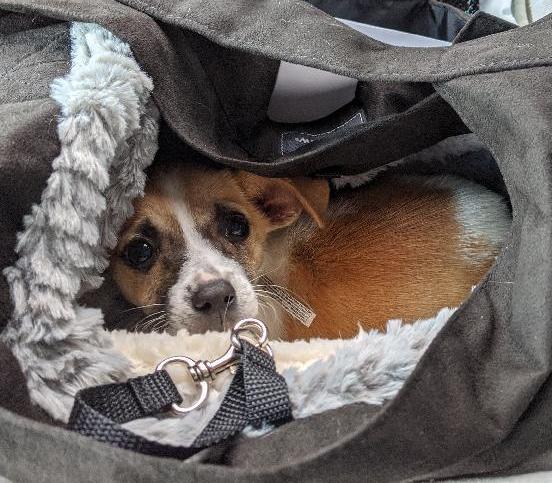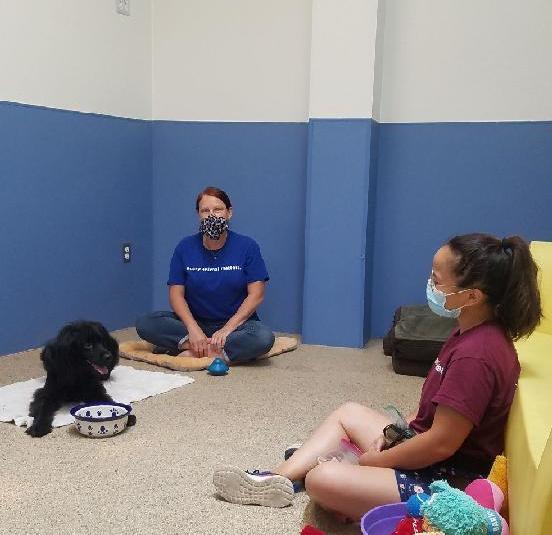
13 minute read
THINKING OUTSIDE THE SHELTER
r e s c u e Thinking Outside the Shelter
Melissa Taylor presents some inspiring examples of case studies where volunteers trained in animal behavior have played a key role in helping new owners address behavior issues, thereby keeping the animals in their homes – and out of the shelters
Advertisement
Like many shelters, my shelter, Friends For Life Animal Shelter in Houston, Texas, relies heavily on volunteers to meet the needs of program animals. In 2019, our volunteers donated 21,046 hours – enough to replace 10 fulltime employees. Every day, these generous individuals spend shifts walking dogs, playing with cats, and cleaning kennels, but they also devote much of their time to behaviorrelated duties.
Behavioral services for companion animals can be so resource intensive that shelter administrators may consider inhouse behavior programs to be a luxury rather than a necessity. When shelter leadership does take a chance on starting up a behavior department, minimal funding is often allocated. Our shelter was no exception: Friends For Life’s (FFL) behavior program started out as a department of one. Unsurprisingly, FFL had more behavior cases than one person could handle. The ability of the department to function effectively came to depend on the support of skilled volunteers.
The previous issue of BARKS featured an article about the feline track of our tiered shelter behavior volunteer (BV) program, which provides participants with classroom and handson instruction (see Building a Feline Behavior Volunteer Program…from Scratch, BARKS from the Guild, September 2021, pp.38‐42). In exchange, our BVs use their newfound knowledge and ability to offer services to our program animals, including enrichment, playdates, manners training, and behavior modification. The more senior BVs donate some of the most impactful hours of all, helping animals not enrolled in our adoption program.
Community Outreach
FFL does its best to be more than an adoption and surrender center. Community outreach, including services related to companion animal behavior, is at the core of our vision. We are approached to help an average of 180 animals a year through the behavior branch of our Thinking Outside the Shelter (TOS) program, which is geared toward providing assistance to animals in underserved communities. Some come to us at immediate risk of surrender to shelters, others are enrolled at humane organizations without behavior departments, and many have caregivers unable to afford behavioral counseling.
Taking into account our already intimidating inprogram caseload at the shelter, there is no way our staff could also handle the TOS cases. Fortunately, our BVs lend us a hand, keeping these animals in homes and out of shelters. Let’s examine a few case studies.
Pepper was an extremely fearful 4-month-old puppy when she ended up at an overcrowded municipal shelter in spring 2020. She was picked up as a foster by Edith, whose young son could not resist Pepper’s vulnerability and shyness. Typically, Edith derived satisfaction from fostering, but caring for Pepper turned out to be an uphill battle.
© Friends For Life (Left to right) Owner Kate, Blake the dog, and behavior volunteer Laura practice cooperative vaccination, reducing stress associated with the procedure and making restraint unnecessary
Case Study #1 ‐ Harry and Jennifer: Harry the dog ended up at a
municipal shelter at about 7 months old. He was so frightened he would not come out of his kennel when adopters Anna and Zach came to meet him and take him home. Harry gradually bonded with Anna, but took much longer with Zach. Although he eventually blossomed, becoming a confident and affectionate dog around them, he remained “aloof and avoidant” towards new people. He generally stayed away, occasionally sniffing or taking a treat from them.
Keeping in mind how fearful Harry was, Anna and Zach made an effort to expose him to people at their apartment. They tried a few strategies: asking visitors to meet Harry outside, look away from him throughout the visit, and toss treats from a distance. Instead of relaxing around strangers, Harry started staring and growling at them.
When Harry bit a houseguest’s leg, Anna and Zach were horrified and at a loss. Harry had “seemed fine,” and, as far as they could tell, hadn’t shown any sign of stress. When they contacted FFL regarding his behavior, they felt Harry was unpredictable and his bites, while never breaking skin, happened at random. Anna and Zach were frustrated and thought he might not be compatible with their lives.
They had an initial screening call, followed by a meeting at the shelter with Jennifer Pallanich. Jennifer joined FFL as a volunteer in early
2017 and, within weeks, signed up as a BV. Before the end of 2020, she earned her CPDTKA through the Certification Council of Professional Dog Trainers. Even though she is now employed at FFL as a behavior technician, Jennifer continues to donate time as a level 4 BV by seeing TOS cases.
Fearful Behavior
For Harry, Jennifer’s first priority was managing his fearful behavior around strangers. She coached Anna and Zach to avoid exposing him to unfamiliar people. Any necessary visitors were to be instructed to send a text message upon arrival, instead of ringing the doorbell, and Harry would stay in a separate, closedoff room with a tasty, longlasting treat.
Harry and his adopters practiced eye contact, sit, down on a mat, and nosetargeting a rubber disc around people in his “inner circle,” with whom he was most comfortable and affectionate. When Harry was proficient at carrying out these skills with familiar people and in a variety of situations, he began to meet novel people using these tasks. He took as many as four meetings to feel comfortable enough to play with and solicit affection from the first people he met through this sequence. Gradually, he required only one session to meet new friends successfully.
Anna and Zach were amazed to see Harry showing his affectionate and bubbly personality around other people after just one meeting. Play was a big part of Harry’s ritualized introduction to new people. Now, when he’s feeling very comfortable, he punctuates play with what his adopters call the signature “Harry Howl, ” which he used to save only for them. Now, he does it every time he’s reached the end of his stranger ritual. Where once Harry hid, stared, and froze around strangers, he now nuzzles them and bounds around playfully.
The biggest victory regarding Harry’s case was Anna and Zach’s realization that Harry did not have to be a social butterfly for him, or them, to be happy. It was great that Harry had a safe and pleasant way to meet new friends, but if he wanted to sit out social gatherings, that was fine, too. While Jennifer helped Harry fit into his adopters’ lifestyle, they had also adapted their lives to fit him. (See also the video, Ritualized In‐troduction to Unfamiliar People for Fearful Dogs to learn more about training a ritualized introduction to new people for dogs or cats who are fearful of strangers.)
Case Study #2 ‐ Blake and Laura: One advantage of including volunteers in the behavior team at FFL is that many members have useful professional skills outside of animal training: teacher BVs are great speakers for humane education events, writer BVs create informational materials, and veterinary professional BVs assist with cooperative care training for animals like dog Blake, who are uncomfortable with routine vaccinations, blood draws, and exams.
Blake was 16 months old when he was displaced after Hurricane Harvey. A month later, he was adopted by Kate, Benn, and their two children. This sweet family adored Blake because he was patient, playful, and tolerant towards their kids and their young friends who visited frequently for playdates. But, after settling into their relatively quiet home, Blake started barking vociferously in his yard, at adult guests to the house, and on neighborhood walks. Blake was also extremely difficult at vet visits, panicking for routine vaccinations and blood draws.
Crossroads
When Kate contacted us, their family was at a crossroads. Blake was a wonderful dog for the family, but his challenges were such that they considered rehoming him. Again, our corps of BVs were there to help Blake overcome his issues, particularly where it came to providing him with veterinary care.
Level two BV Laura Innis' knowledge melded especially well with her behavior interest: she is a veterinary technician with a passion for gentle, animalcentered care. She helped Blake feel comfortable with veterinary procedures, training him to initiate counterconditioning exercises by building an association between injections and salmon, his favorite treat. For example, he could automatically sit on a stationing

© Friends For Life Initially, 4monthold puppy Pepper was so fearful, she would barely come out of hiding

© Friends For Life After behavioral counseling and lots of practice, Pepper was much more comfortable going on adventures with her family

© Friends For Life Céline and Lynn conduct in a feline behavior consult on Zoom: It takes an average of 13 classroom hours to complete four levels of behavior volunteer training and the pair now colead upto 19 cat behavior consultations a month

mat and focus on his treats, which was the cue to proceed with the vaccination training. He also had the choice to opt out of these exercises by disengaging or moving away. It was so satisfying for our team to see Blake sitting calmly for vaccinations, without restraint or distress, for the first time! (See video, Blake the Dog Demonstrates Cooperative Vaccina‐tion where Blake, previously a nightmare around needles, lies on a mat and rests his chin on Kate’s leg, so she can give him vaccinations her‐self.)
Case Study #3 ‐ Pepper and Katie: The whole point of the TOS pro
gram is to support companion animal caregivers so they can keep their animals in their homes and out of the shelter system. To this end, we also help animals at the other end of the process: finding their way from the shelter into a home.
Pepper was an extremely fearful 4monthold puppy when she ended up at an overcrowded municipal shelter in spring 2020. She was picked up as a foster by Edith, whose young son could not resist Pepper’s vulnerability and shyness. Typically, Edith derived satisfaction from fostering, but caring for Pepper turned out to be an uphill battle.
Cowering in Fear
Soon after bringing her home, Edith had to rush Pepper to an emergency clinic. She was diagnosed with kennel cough, a variety of parasites, and an ear infection. But even once she was healthy again, Pepper cowered in fear from Edith and her family and wouldn’t look at them. She mostly stared at a wall and lay in her kennel. She only ate when Edith hand fed her, never on her own.
When we received Edith’s request for help, we arranged for a consultation with Katie Harnish, a level 4 BV who had earned her CPDTKA in 2019. Katie was a regular at the shelter, walking and training our more difficult dogs and mentoring newer volunteers. She was an educator whose positive, patient demeanor never failed to bolster the spirits of those at the human end of the leash.
Through her work with Edith, Katie quickly figured out that Pepper was much more comfortable outdoors than inside Edith’s home. This inspired Edith to patiently practice trustbuilding exercises starting from outside her home. Within two months, Pepper began eating more autonomously, playing, and acting like a healthy, happy, lively puppy. After having overcome so much hardship together, Pepper’s fosters decided to make her a permanent addition to their family!
Case Study #4 ‐ Lynn and Céline: It takes an average of 13 classroom hours for each participant to complete four levels of BV training. While this may seem like a steep investment, it pays off in dividends as BVs apply their knowledge to shelter duties. Take Céline Germain and Lynn Hernandez, for example: they’ve recently completed BV4 together and colead as many as 19 cat behavior consultations a month.
One such case involved feral kittens Stretchy, Snowball, and Butterbeans, who had been found by fosterer Allan at seven weeks old. They weren’t thriving and he was concerned for their survival when a fourth littermate died of an eye infection, so he took them in.
© Friends For Life Harry earns treats by lying down on a mat and making eye contact during the early stages of meeting Olivia Sisson (right) for the first time, overseen by behavior volunteer Jennifer Pallanich
Undersocialized
After their health, Allan’s main concern was socializing the kittens, who had missed out on critical exposure to humans. He knew that undersocialized cats would not have the best chance at adoption. Allan was retired, so he had plenty of time for training, but after spending over $1,000 on vet bills, behavior consultation fees seemed out of reach. Lynn and Céline responded to Allan’s TOS request and scheduled a Zoom consult, to avoid putting the kittens through the stress of a house call.
The kittens readily relaxed and played around Allan, but weren’t completely comfortable with much handling. Allan had been picking them up and petting them for as long as they tolerated it, but the kittens had made limited progress over their three months in foster care. Lynn and Céline recommended pairing momentary noninvasive petting with the kittens’ favorite treats, starting with their neck and chest area, then gradually moving on to longer periods of contact and other parts of their bodies. They demonstrated these handling exercises with cats at the shelter and observed Allan practicing with the kittens to make sure that he could train them on his own. After six weeks of consultations, the kittens were able to wait patiently for a treat while being touched on their ears, tail, paws, and mouths. They were even relaxed while being picked up. Just in time to meet some potential adopters!
Community Resource
The modern animal shelter is a community resource. It cares for pets long before they are relinquished and continues providing support once they are in homes to ensure that placements last. Similarly, the modern volunteer operates beyond the shelter. It’s not that BVs like Jennifer, Laura, Katie, Céline, and Lynn don’t also clean kennels, take dogs for walks, and feed our residents every day. But through our specialized training program, we have broadened our collective capacity for helping companion animals in need, including those outside our shelter walls. n
The author would like to thank Jennifer Pallanich for her editing prowess.
Resources
Behavior Team. (2020, August 30). Ritualized Introduction to Unfamiliar People for Fearful Dogs [Video File] Behavior Team. (2021, August 22). HarryEmily 2ndStrangerRitualHowl [Video File] Behavior Team. (2021). Blake the Dog Demonstrates Cooperative Vaccination [Video File] Taylor, M. & Zeman, A. (2021, September). Building a Feline Behavior Volunteer Program…from Scratch. BARKS from the Guild (50) 38-42
Melissa Taylor CBCC-KA is the behavior and training manager at Friends For Life Animal Shelter in Houston, Texas. She has logged more than 20 years in shelter animal behavior, starting with an internship at the ASPCA’s Animal Behavior Center in New York City. She developed a lasting love for cooperative care from training livestock and wildlife as the coordinator of the behavior and training department at the Houston SPCA, and applies the same principles to the dogs, cats, exotics, and humans she works with now at Friends For Life. Over the course of her career, she has focused on the development of shelter humane education programs, particularly those for volunteers, with the intention of mentoring new companion animal trainers and behavior consultants with practices steeped in evidence and based on building trust, security, and partnership. Melissa has started several shelter behavior volunteer programs, and consults with other humane organizations on starting such initiatives of their own.

www.petdogambassador.com











